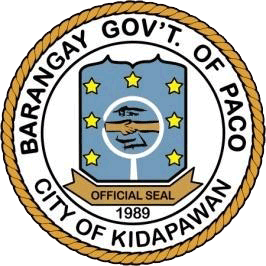Paco
 In the year 1934, Paco was a vast forest where wild animals lived. The first known inhabitants of the place were Bagobos. They lived in small houses made of wood, cogon
In the year 1934, Paco was a vast forest where wild animals lived. The first known inhabitants of the place were Bagobos. They lived in small houses made of wood, cogon
grass and Lawaan bark. Their clothes were made of woven wild abaca fibers. Their way of living was through “Kaingin” or cutting and burning of trees. Aside from that, they’re also into planting rice and root crops as their source of livelihood. The name Paco originated from a plant called ferns or locally known as “pako”. This plant grew mostly in river banks and usually cooked into salad. Formerly the Bagobos were ruled by their DATUS who acted as their chieftain. Most of them lived in the river banks where “pako” usually grow. The place has also a beautiful spring where they get their water for household consumption found along the Paco River. The first elementary school in the place was actually located near the spring which is now named as Paco Elementary School. This school was headed by Mr. Paterno Santiago, Sr., the first teacher in the place. Since then, education was introduced in the place. Among those who first successfully gained their education were Mr. Linog Guabong, Taligtig Diaman
Mancera, Atty. Jhonny Sibug, Atty. Mr. Leonido Delante, and Atty. Cresencio Descartin, Agustin Quiros. The first appointed leader (Teniente Del Barrio) was Mr. Venedicto Grado. The first Elected Teniente Del Barrio was Mr. Jose Tolosa, followed by Mr. Feliciano Buton, Mr. Vicente Lamac-Lamac Sr. and the first elected Barrio Captain was Mr. Carlos I. Rapiz, Sr. who became the leader of the place for a long period of time during the Martial Law. It became a regular Barrio through Resolution No. 50 during the time of the Honorable Alfonso Angeles, Sr.
Presently, Barangay Paco has two (2) elementary schools serving elementary population in the area aging 6-12 years old and one (1) high school situated approximately 300 meters away from the Centro.
